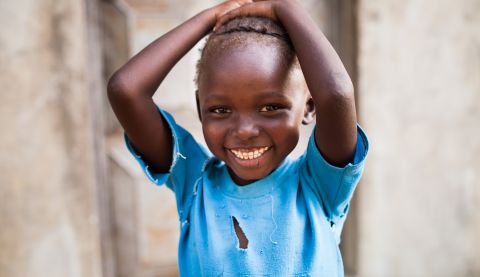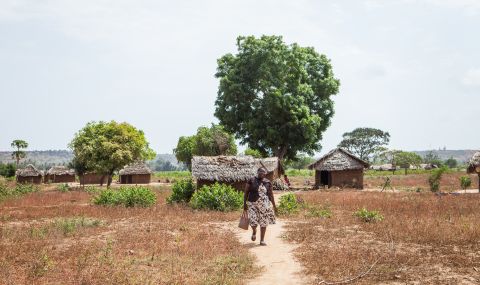5 links between poverty and violence against women
7 March 2018
Living in poverty increases the risk of women and girls experiencing violence. But how does poverty cause gender-based violence? Find out more, and see how you can support ActionAid's work.

How does poverty contribute to gender-based violence? Find out the impact it makes. Photo: ActionAid
Violence against women and girls is a daily reality, experienced in every country, every city and every town throughout the world. One in three women globally will experience sexual or physical violence in their lifetime, most likely at the hands of an intimate partner such as a husband or boyfriend.
Living in poverty increases the risk of women and girls experiencing violence. Find out five key ways poverty is linked to violence, and how you can help.
Violence against women and girls is a barrier to ending poverty
As well as being a violation of human rights, violence against women and girls is a fundamental barrier to eradicating poverty.
It traps individual women and girls into poverty and its many consequences (economic hardship, social marginalisation and the denial of basic human rights, to name a few), deepen existing economic inequality between women and men.
Women and girls from other marginalised groups, such as LBT and disabled women, are at increased risk of experiencing violence, and more likely to live in poverty. Though it's mainly women and girls who suffer, violence also brings negative impacts for their families, communities and countries.
1. Violence squanders women’s life-opportunities
Violence against girls in schools directly leads to poor performance, lower enrolment, absenteeism and high drop-out rates. According to UNESCO, almost a quarter of young women aged 15-24 (116 million) in developing countries never completed primary school.1 This means they lack skills for getting good jobs and the confidence to defend their rights.
Women with an education are able to earn a higher percentage of what men earn. Girls with higher levels of education are less likely to get married at an early age. UNESCO states that if all girls had a secondary education, there would be two-thirds fewer child marriages.2
The younger a woman or girl is when she’s married, the higher the risk, severity and frequency of violence perpetrated by her partner. Children born from child and early marriages, are less likely to receive education and more likely to live in poverty.
Joyce from Kilifi in Kenya now works as an ActionAid paralegal helping survivors of violence, having been raped when she was 17.

Joyce is an ActionAid-trained volunteer paralegal in Kilifi county, Kenya. She is a survivor of domestic violence and child marriage. Now she helps women and girls who have experienced sexual assault to get justice .
Joyce describers what she went through:
After being raped I got pregnant. Going back home, the community plus my parents were not able to pay for my school fees, therefore forcing me to get married to this man who raped me."
This shows how living in poverty was a direct cause of the violence Joyce continued to experience after being married to her rapist.
2. Poor women have less opportunity to flee
This is probably the most obvious of the links between poverty and violence against women and girls. Women and girls who are poor, are more reliant on men to support them financially.
Having no money to leave, to find shelter, or to buy food is one of the critical reasons why women and girls stay in violent relationships. Women who earn an income who are in coercive and/or violent relationships often have this income controlled by their partner.
Women who experience domestic violence by an intimate partner are more likely to be coerced into pregnancy – reducing their ability to earn an income and forcing them to become more reliant on their abusive partner.
This was the case for Joyce. She was raped the same year that her mother died. She says:
I lived as a girl with a lot of challenges. I felt so alone."
With no money, a baby to feed and rejection from her community, she had no way to leave her husband. She had ten children in total, eight of whom died.
3. Violence keeps women and girls poor
Women who experience violence at the hands of an intimate partner often also have their behaviour controlled and are less likely to be able to find work. They may also miss days of work or other opportunities due to injury.
Violence is also used in the world of work to oppress and control women. It is estimated that globally, up to half of all women experience some form of sexual harassment while at work3. The physical and psychological harm this causes can lead women to leave jobs, miss days of work, and deter them from pursuing promotional opportunities, or seeking compensation.
Now 50 years old, Joyce has left her husband and works as a paralegal at the Access to Justice project in Kenya – a partnership between ActionAid and the Wangu Kanja Foundation.
Joyce was trained as a paralegal by ActionAid around five years ago. She explains:
After I joined ActionAid, I felt the need to help other girls – or other women – who went through my struggle. When I went to the conferences and seminars organised by ActionAid, I felt that it’s good to give back to the community.
Part of Joyce's work is to raise awareness about women's rights and the law in her community, and support survivors through the legal system and in accessing health care.
4. Poor women are at higher risk of sexual exploitation and trafficking
Women and girls living in poverty are more vulnerable to sexual exploitation, including trafficking. At least 20.9 million adults and children are bought and sold worldwide into commercial sexual servitude, forced labour and bonded labour.4
Women and girls make up 96% of trafficking for sexual exploitation victims.5
Girls in Joyce's area in Kenya are at particular risk of rape and sexual assault because of an influx of male factory workers, and the poverty that they experience increases their vulnerability to abuse, especially during long walks to and from school alone.
To end violence, women and girls must have ownership of their own bodies.

Joyce helps girls understand their rights and the risks of violence so they know how to avoid danger and seek help .
In many families, boys' needs are given a higher priority than girls' needs. Joyce explains: "Girls are given a lot of house chores which makes them tired and walk into danger. For the girl child, it is much harder than for the boy child."
5. Violence has huge social and economic costs
Violence against women and girls results in lasting physical and psychological damage affecting women world-wide including broken limbs, depression, disability, infections such as HIV, miscarriages and even death.
Social stigma also causes isolation. Joyce describes:
After rape, most girls are left lonely: the community or family abandons them. Others lack peace, are crippled, get infections, get mentally disturbed and might end up killing themselves. So far, we have tackled one case of a girl who took her life after rape and we have two cases where girls have been killed after rape."
As well as these devastating costs on the lives of women and girls, such violence has huge social and financial costs. Many governments struggle to fund workable solutions for these, made harder by a lack of political will to give the issue the priority it so urgently needs.
While it is difficult to measure, even the most conservative estimates put countries' costs in the billions of dollars.
These can be direct costs for policing, courts and health care or indirect costs from lost opportunities through girls missing education and women having to take time off work or even losing their jobs.
This is why ActionAid's work training women like Joyce to support girls is so important.

Joyce talking to a young girl who was raped when she was six years old. A man lured her into his house, tied a cloth around her mouth and raped her. ActionAid are helping Esther seek justice through the Sauti Women's Network and paralegal support.
Joyce explains:
Together with the parent, we take the girl to hospital, to the police, and then we see a doctor who will accompany us to court."
ActionAid also pays for the associated costs such as travel and legal fees, which many women and girls living in poverty cannot afford.
Women leading efforts to end violence
Women and girls are calling time on this violence and economic injustice. Women all over the world are coming together – as they have done for decades – to demand change within their communities, often at great personal risk.
ActionAid is proud to support and work alongside many such women’s rights organisations and movements. By making a regular donation to ActionAid, you can help ensure the vital work of women such as Joyce can continue.
Joyce describes how her understanding from her own experience of violence gives hope to the women and girls she supports:
I sit with them, as a woman who has gone through rape myself, I explain my story and through it they get to be healed. Rape is not the end of life. You can continue."
How you can help end violence against women
If you give a regular gift to ActionAid, you can help us be there for women and girls in some of the poorest countries around the world.
You can help us support incredible women like Joyce, and fight poverty and violence so that all women, everywhere, can create the future they want. Please donate now.
Footnotes
- 1https://en.unesco.org/gem-report/sites/gem-report/files/girls-factsheet-en.pdf
- 2https://en.unesco.org/gem-report/sites/gem-report/files/girls-factsheet-en.pdf
- 3https://www.ituc-csi.org/IMG/pdf/stop_gender_based_violence_at_work_en_final-2-2.pdf
- 4https://www.equalitynow.org/sex-trafficking-fact-sheet
- 5www.equalitynow.org/sex-trafficking-fact-sheet



